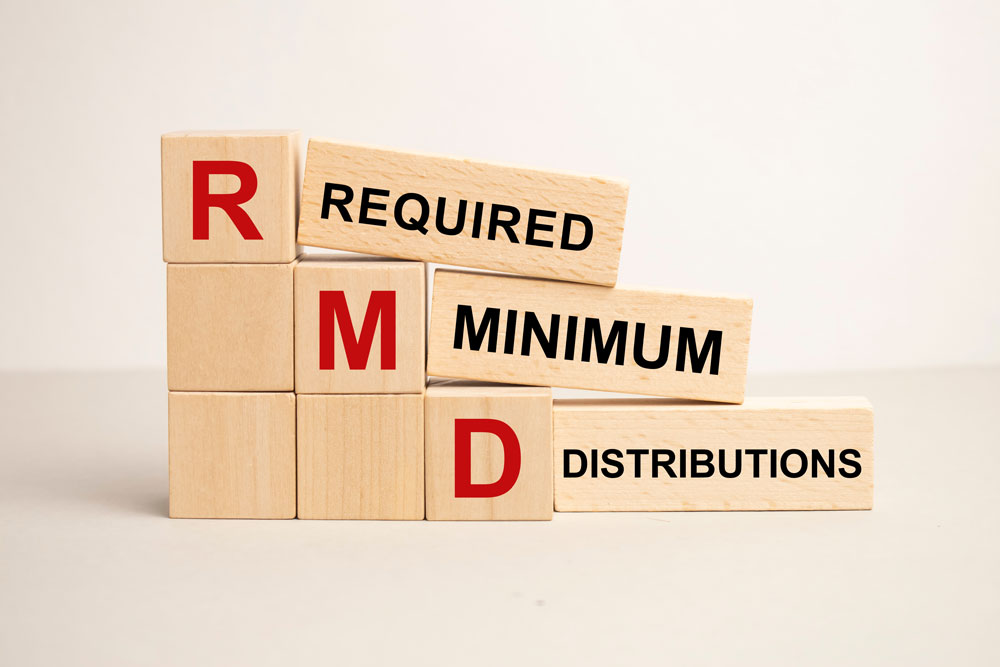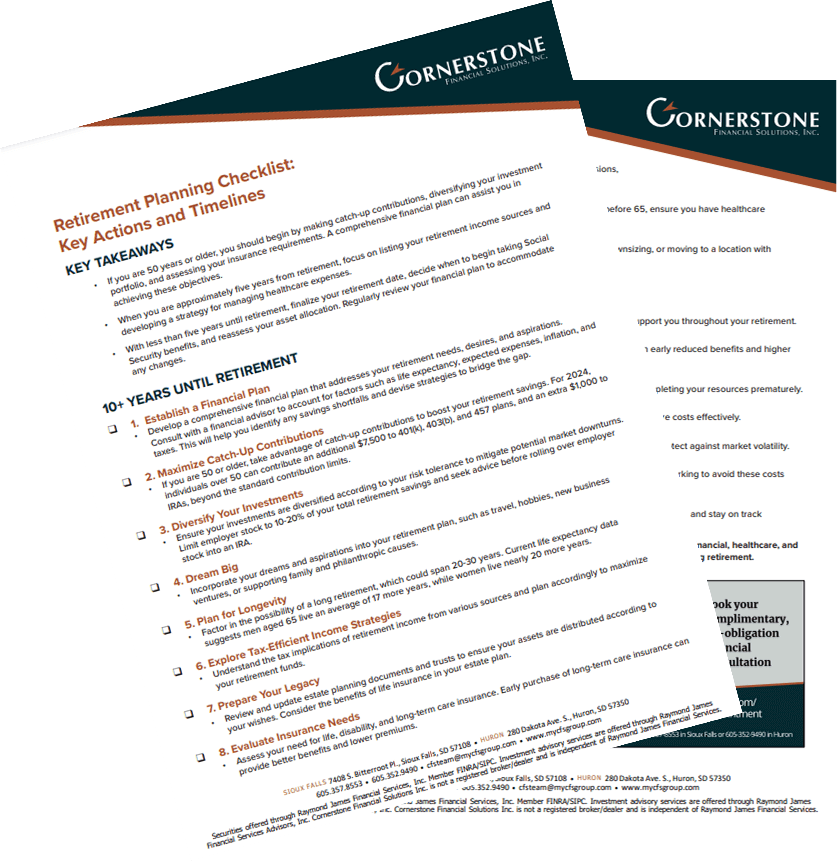Confusion Over Required Minimum Distributions (RMDs)
Cornerstone is pleased to bring you this article by Ed Slott and Company, LLC, an organization providing IRA education and analysis to financial advisors, institutions, consumers, and media across the country. Our association with this organization helps us stay up to date on the latest developments in IRA and tax law. As always, give us a call if you’d like to discuss! Originally published October 2023.
To the surprise of many, the IRS released proposed SECURE Act regulations last year requiring beneficiaries (on some occasions) to take required minimum distributions (RMDs) during the 10-year payout period.
In the past, most non-spouse beneficiaries could “stretch” RMDs from inherited accounts over their own single life expectancy. RMD rules for 2023 are more confusing, thanks to the 2019 SECURE Act passed by Congress, and IRS proposed regulations of Feb. 23, 2022.
The 2019 SECURE Act included the 10-year payout rule, requiring most retirement account beneficiaries for deaths in 2020 or later to empty the retirement account by the end of the 10th year following the year the account owner died.
The IRS issued proposed regulations on February 23, 2022, taking the position that when death occurs on or after the required beginning date (RBD), a non-eligible designated beneficiary must take annual RMDs and empty the account under the 10-year rule.
The rule requiring annual RMDs when an account owner dies on or after her RBD is sometimes called the “at least as rapidly” (ALAR) rule. While it does not require the beneficiary takes the same amount that the IRA owner was taking, it does require that the process of taking RMDs continue. This interpretation surprised many who thought the 10-year rule would apply like the pre-SECURE Act 5-year rule, which did not require annual RMDs.
How has the IRS responded to RMD confusion?
The IRS has waived some RMD penalties when certain beneficiaries fail to take an RMD due to a reasonable error. Waivers are only applicable to RMDs within the 10- year period and you are usually required to file Form 5329 to request a waiver. For 2023, SECURE 2.0 reduces the penalty from 50% to 25% of the amount not taken. The penalty is further reduced to 10% if the missed RMD is taken and the penalty is paid during a 2-year correction window.
Last year, the IRS issued Notice 2022-53, which waived penalties for missed 2021 and 2022 RMDs within the 10-year period, for deaths that occurred in 2020 or 2021. Recently, the Service released Notice 2023- 54, extending the penalty waiver to cover missed 2023 RMDs when the death occurred in 2020 or 2021. It also excuses the penalty for missed 2023 RMDs when the death took place in 2022.
Although the Notice does not state this directly, it appears that since the penalty is waived, the 2023 RMD, like 2021 and 2022 RMDs within the 10-year period, doesn’t have to be taken. It also appears that these missed RMDs within the 10-year period will not have to be made up. (Note that if these RMDs were already withdrawn, they cannot be returned or rolled over.)
Example:
Lola died in 2020 at age 75 with a traditional IRA. Her adult daughter, Anabella, is a non-eligible designated beneficiary subject to the 10-year rule under the SECURE Act.
WHY? The proposed regulations say that because Lola died after her RBD, Anabella must take RMDs based on her single life expectancy during years 1-9 of the 10-year period. However, Notice 2022-53 says that if Anabella failed to do so for 2021 and 2022, there is no penalty on the missed RMDs. Notice 2023-54 extends this relief to the 2023 RMD. If Anabella had already taken a distribution, believing she needed to take an RMD for 2023, she may not roll over those funds. Notice 2023-54 also provides relief to successor beneficiaries subject to RMDs within the 10-year rule.
Example:
Dave died in 2019 at age 90 with a traditional IRA. As designated beneficiary his adult son, Russell, can take annual RMDs from the IRA because Dave died before the SECURE Act became effective.
Russell dies in 2020. His son Theodore, the successor beneficiary, is subject to the SECURE Act and the 10-year rule, and must also take RMDs based on Russell’s single life expectancy during years 1-9 of the 10-year period. However, Notice 2022-53 said that if Theodore failed to take his 2021 or 2022 RMD, there would be no penalty. Notice 2023-54 extends this relief to 2023 RMDs. Beneficiaries who inherited a Roth IRA do not need this relief. Under the IRS proposed regulations, anyone who inherits a Roth IRA is deemed to have inherited from a person who died before his RBD. This is because Roth IRA owners are not subject to lifetime RMDs. Most Roth IRA beneficiaries are still subject to the 10-year rule, but RMDs are not required for years 1-9.
Does Notice 2023-54 waive all RMDs for 2023?
No. The Notice doesn’t affect lifetime RMDs, inherited IRAs by eligible designated beneficiaries (EDBs), or RMDs by beneficiaries who inherited before 2020.
Example: Monica has an IRA. She is 80 years old and must take a lifetime RMD for 2023. If Monica fails to do so, Notice 2023-54 doesn’t provide any relief from the penalty.
Example: Arthur inherited an IRA from his mother in 2018. Arthur has been taking RMDs each year based on his single life expectancy. Because he inherited prior to the SECURE Act, Arthur can continue the stretch. However, if he fails to take an RMD in 2023, Notice 2023- 54 does not relieve him from the penalty.
Should every beneficiary who is eligible for the IRS relief skip their RMD for 2023?
Anyone who is eligible for this relief also has the 10-year deadline looming. So, while it may be tempting to skip an RMD for 2023, that could mean more pain later when a big tax bill comes due at the end of the 10-year holding period.
Does the recent guidance tell us what will happen with RMDs during the 10-year period in the future?
The IRS is not tipping its hand. The latest notice says, “Final regulations regarding RMDs will apply for calendar years beginning no earlier than 2024.” Hopefully, those final regulations will arrive sooner rather than later and offer clear direction.
Which IRA owners get more time to complete a rollover?
While Notice 2023-54 mainly addressed RMD confusion during the 10-year rule for beneficiaries, it also provided very targeted relief to a specific group of IRA owners — those born in 1951. The Notice extends the 60-day rollover deadline for these IRA and plan account owners affected by the SECURE 2.0 increase in the first RMD age from 72 to 73.
Under the old rule, the first RMD year for account owners born in 1951 would have been 2023. Under SECURE 2.0 it is now 2024.
Some IRA custodians and plan administrators inadvertently paid out “RMDs” in 2023 to these people. Because these weren’t technically RMDs, and the account owners may not have wanted them, the IRS gives these account owners additional time (beyond the usual 60-day period) to roll back distributions received between January 1, 2023, and July 31, 2023. The extended deadline is September 30, 2023.
Such a rollover will not violate the once-per-year IRA rollover rule if another distribution was received by the individual in the last 12 months that was also rolled over. It will start a new 12-month period that will preclude a distribution received in the next 12 months from being rolled over.
Example: Mick reached age 72 in 2023. He was unaware that SECURE 2.0 delayed the RMD age to 73. On January 10, 2023, he took a distribution from his IRA, believing he needed to take an RMD for 2023. Mick realized his error a few weeks later. Mick has until September 30, 2023, to roll over this distribution if he so chooses. If Mick had already done a rollover of another distribution received in the last 12 months, that will not preclude him from rolling over the 2023 RMD distribution “mistake.” However, going forward, any distribution Mick takes from any IRA before January 10, 2024, will not be rollover eligible.
Membership in Ed Slott’s Elite IRA Advisor Group™ is one of the tools our advisors use to help you avoid unnecessary taxes and fees on your retirement dollars. Gordon attends in-depth technical training on advanced retirement account planning strategies and estate planning techniques. And semiannual workshops analyzing the most recent tax law changes, case studies, private letter rulings, Congressional action and Supreme Court rulings help keep attendees on the cutting-edge of retirement, tax law and IRA distribution planning. Through his membership, Gordon is immediately notified of changes to the tax code and updates on retirement planning, and he has 24/7 access to Ed Slott and Company LLC to confer with on complex cases.
This information, developed by an independent third party, has been obtained from sources considered to be reliable, but Raymond James Financial Services, Inc. does not guarantee that the foregoing material is accurate or complete. Changes in tax laws or regulations may occur at any time and could substantially impact your situation. Raymond James and its advisors do not offer tax or legal advice. You should discuss any tax or legal matters with the appropriate professional.
Copyright ©2023, Ed Slott and Company, LLC Reprinted from The Slott Report, August 14, 2023 with permission. https://www.irahelp.com/slottreport/rmd-relief-no-thank-you. Ed Slott and Company, LLC takes no responsibility for the current accuracy of this article. Raymond James is not affiliated and does not endorse Ed Slott and Company, LLC, The Slott Report, The Elite Advisor Group™, or Sarah Brenner, JD.
CSP #328338-2 Exp 10.24.25





